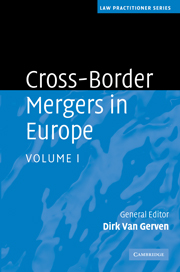Book contents
- Frontmatter
- Contents
- Contributors
- Preface
- Part I EC rules on cross-border mergers
- 1 Community rules applicable to cross-border mergers
- 2 Employee participation: rights and obligations
- 3 Tax rules applicable to cross-border mergers
- 4 Scope and limitations of the Cross-border Merger Directive
- Part II Application in each Member State National reports for the EU Member States
- Part III Application in the EEA Member States
- Part IV Annexes
- Index
3 - Tax rules applicable to cross-border mergers
from Part I - EC rules on cross-border mergers
Published online by Cambridge University Press: 03 May 2010
- Frontmatter
- Contents
- Contributors
- Preface
- Part I EC rules on cross-border mergers
- 1 Community rules applicable to cross-border mergers
- 2 Employee participation: rights and obligations
- 3 Tax rules applicable to cross-border mergers
- 4 Scope and limitations of the Cross-border Merger Directive
- Part II Application in each Member State National reports for the EU Member States
- Part III Application in the EEA Member States
- Part IV Annexes
- Index
Summary
Introduction
Purpose
1. Cross-border mergers entail a transfer of the assets and liabilities of at least one company (‘the transferring company’) which ceases to exist as a result of the merger, to a newly created or an existing company established in another State (the ‘receiving company’). To the extent that such transfer goes hand in hand with a relocation of business or a physical transfer of assets, the merger will cause the State of the transferring company to lose potential tax revenue. For this reason, most States only allow domestic mergers to be carried out in a tax-neutral way.
The absence of a tax-neutral regime for cross-border mergers constitutes a clear impediment to international reorganisations and integrations of companies. Already by 1969, a proposal for a directive was drafted by the European Commission, which prohibited taxation in case of intra-community mergers.
It took more than twenty years to enact this proposal as Council Directive 90/434/EEC of 23 July 1990 on the common system of taxation applicable to mergers, divisions, transfers of assets and exchanges of shares concerning companies of different Member States, hereafter ‘the Merger Tax Directive’ (‘Tax Dir.’).
The Merger Tax Directive provides for a common tax system applicable throughout the Community. The simple extension at the Community level of the national tax-neutral regimes for domestic mergers was considered to be insufficient because of the risk that differences between these national regimes would continue to produce distortions.
- Type
- Chapter
- Information
- Cross-Border Mergers in Europe , pp. 44 - 53Publisher: Cambridge University PressPrint publication year: 2010
- 1
- Cited by



